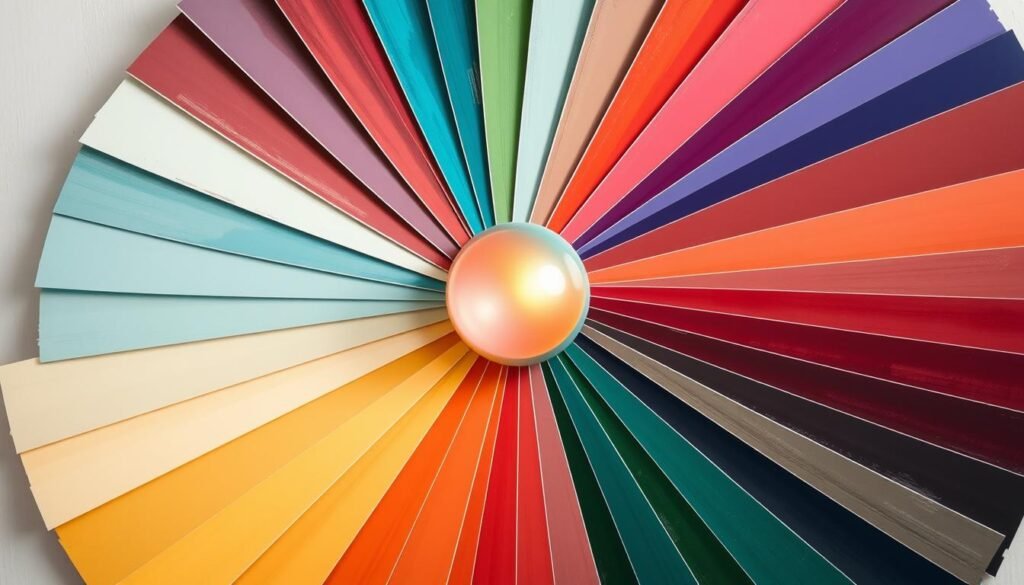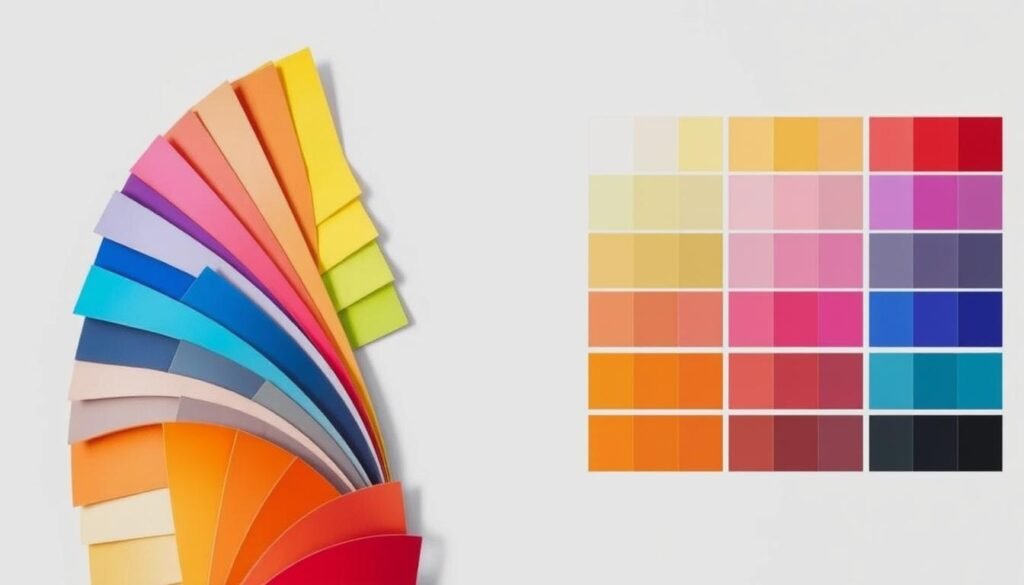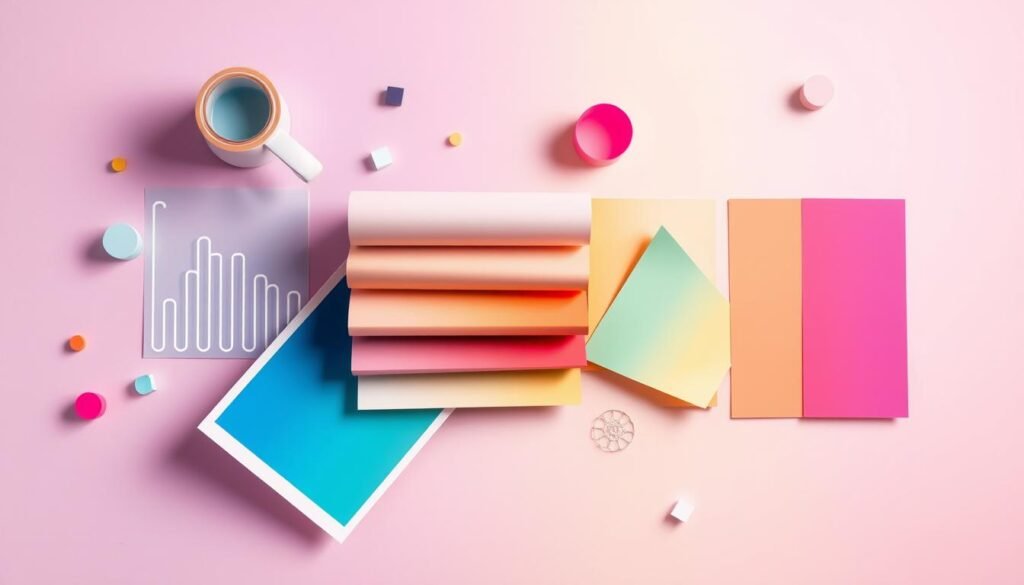Did you know 87% of people feel more confident and stylish when they wear colors that match their skin undertones1? Finding your perfect color palette can change how you see yourself. ChatGPT makes it easy to discover your ideal shades with great accuracy. This is your go-to guide on using ChatGPT for a personalized color analysis.
Key Takeaways
- Skin undertones fall into warm, cool, and neutral categories, which ChatGPT can help determine1.
- The color analysis process involves selecting colors from 2-3 areas of the face for detailed examination1.
- ChatGPT outperforms traditional tools like Bing in providing accurate color analysis results1.
- The AI can recommend suitable makeup shades and accessories based on your unique color profile1.
- Specific color codes can be extracted for clothing and makeup selection1.
What is Color Analysis and Why is it Important?
Color analysis is a way to find the best colors for your skin, eyes, and hair2. It groups people into four seasons: Winter, Spring, Summer, and Autumn. Each season has colors that match your natural look3. Knowing your color season can make you look more vibrant and healthy2.
Understanding the Four Seasons: Winter, Spring, Summer, and Autumn
The four seasons in color analysis depend on your skin undertones, contrast, and color intensity. Winters have cool, high-contrast features, while Autumns have warm, low-contrast ones. Summers are cool with low contrast, and Springs are warm with high contrast4. Knowing your colors helps you choose clothes and makeup that look great on you.
The Role of Undertones, Contrast, and Chroma in Color Analysis
Color analysis looks at your skin undertones, contrast, and color intensity2. These factors help find the colors that match your natural coloring. Wearing the right colors can make you feel more confident and stylish4.
“Color analysis is not just about fashion; it’s about embracing your unique beauty and radiating confidence from the inside out.” – Carole Jackson, author of “Color Me Beautiful”
Using ChatGPT for Personal Color Analysis
In today’s digital world, there’s a smart and affordable way to find your perfect colors. ChatGPT, an AI tool, can help you discover your seasonal colors. It gives you tips on how to wear these colors in your clothes and style5.
Unlike paying a color analyst for $300, ChatGPT is free. It uses AI to find the best colors for you, based on your skin, hair, and eyes. It works for Winter, Spring, Summer, or Autumn types5.
It’s easy to use ChatGPT. Just tell it about your looks, and it will show you your colors. You’ll get a palette with hex color codes for your skin, hair, and eyes. Plus, it suggests clothes and makeup to highlight your beauty5.
With ChatGPT, you get a DIY color consultation that’s easy and helpful. It lets you find your color personality and use color to change your life5.

If you want to update your clothes, makeup, or learn about color theory, ChatGPT is here to help. Start your journey in personalized color analysis and become your most confident, stylish self6.
Step-by-Step Guide to Obtaining Your Color Palette with ChatGPT
Taking the Perfect Selfie for Color Analysis
To start your personalized color analysis with ChatGPT, take the perfect selfie. This step captures your true skin tone, hair color, and eye color in natural light7. Make sure to take your selfie without makeup or accessories that might change how your colors look. Stand in front of a simple, neutral background to highlight your features.
Extracting Color Codes from Your Selfie
After taking your selfie, it’s time to find the key color codes. Use a digital color picker tool, like Photoshop or Canva, to get the hex codes for your skin, hair, and eyes7. These exact colors will help ChatGPT figure out your seasonal color palette8.
With your selfie and color codes ready, you’re set to explore your color analysis with ChatGPT. This guide will help you find your personal color season. You’ll discover new fashion and styling options.

Crafting the Perfect ChatGPT Prompt for Color Analysis
Making a good prompt is key to getting the best color analysis from ChatGPT. Your prompt should have important details like your skin tone, eye color, and hair color9. This way, ChatGPT can give you a color analysis that fits you perfectly.
Essential Information to Include in Your Prompt
When you make your prompt, remember to include these important details:
- Your skin tone (fair, medium, olive, or dark)
- Your eye color (blue, green, hazel, brown, or black)
- Your hair color (blonde, brown, black, red, or gray)
- Any other relevant personal information, such as your age, gender, or body type
By adding these details, you help ChatGPT give you a color analysis that really fits you9. This way, the AI will give you advice that’s just right for you.
Here’s an example of a good prompt for ChatGPT color analysis:
“Provide a detailed color analysis for a woman with fair skin, green eyes, and light brown hair. Give her the best colors and shades for her skin, eyes, and hair. Also, tell her how to use these colors in her clothes and makeup.”
By making your prompt with these details, you let ChatGPT give you a color analysis that’s just for you93.

chat gpt color analysis prompt
Ready to find your perfect color palette and transform your style? ChatGPT is here to help. This AI model offers personalized color analysis prompts to guide you10. Whether you love AI or just want to refresh your style, ChatGPT can give you valuable insights. It helps you discover the colors that look best on you.
Start by creating a prompt that shows your personality and style. Ask ChatGPT to look at your skin, eye, and hair colors. It will suggest the best colors for you10. With ChatGPT’s color theory knowledge and AI suggestions, you’ll find the perfect wardrobe and makeup.
- Prompt Example: “I have warm, olive-toned skin, dark brown eyes, and dark brown hair. What is my seasonal color palette, and what colors should I wear to flatter my complexion?”
- Prompt Example: “I’m a cool-toned individual with fair skin, blue eyes, and blonde hair. Can you suggest a seasonal color palette and specific hues that would complement my features?”
- Prompt Example: “I’m an AI enthusiast looking to optimize my personal style. Can you provide a detailed color analysis and recommendations for my autumn/winter wardrobe and makeup?”
Using these prompts, you’ll get a lot of insights from ChatGPT11. Discover the best colors for your style with ChatGPT’s help. Let it be your color expert and change how you see yourself.

| Prompt Type | Example | Key Details |
|---|---|---|
| Seasonal Color Palette | “I have warm, olive-toned skin, dark brown eyes, and dark brown hair. What is my seasonal color palette, and what colors should I wear to flatter my complexion?” | Focuses on identifying the individual’s seasonal color palette and recommending complementary hues. |
| Cool-Toned Features | “I’m a cool-toned individual with fair skin, blue eyes, and blonde hair. Can you suggest a seasonal color palette and specific hues that would complement my features?” | Tailored to individuals with cool-toned complexions, seeking color recommendations that enhance their natural attributes. |
| AI Enthuasiast | “I’m an AI enthusiast looking to optimize my personal style. Can you provide a detailed color analysis and recommendations for my autumn/winter wardrobe and makeup?” | Designed for AI-savvy individuals seeking a complete color guide for their seasonal style choices. |
Explore color analysis with ChatGPT and find your vibrant self1011.
Interpreting ChatGPT’s Color Analysis Results
After getting your color analysis from ChatGPT, it’s key to know how to read the results. The goal is to find your seasonal color palette. This helps you pick the right shades that make your features pop10.
ChatGPT sorts people into four seasons: winter, spring, summer, or autumn. Each season has its own color vibe. These colors match your skin, eyes, and hair best10.
Understanding Your Seasonal Color Palette
Look closely at what ChatGPT says about your skin and coloring. Winters have cool skin and deep features. Springs and autumns have warm skin and lighter coloring10.
Summers have soft features and cool skin. They look great in soft colors, not bold ones10.
| Season | Characteristics | Best Colors |
|---|---|---|
| Winter | Cool-toned, high contrast, deep coloring | Rich, bold, and jewel-toned colors |
| Spring | Warm-toned, light and bright coloring | Soft, airy pastels and warm neutrals |
| Summer | Cool-toned, muted and soft coloring | Soft, cool-toned blues, greens, and lavenders |
| Autumn | Warm-toned, medium to deep coloring | Rich, earthy tones like oranges, reds, and mustards |
Knowing your seasonal colors can change your wardrobe and makeup game. It lets you pick colors that really suit you10.
Diving Deeper: Sub-Seasons and Personal Customization
Color analysis goes beyond the four main seasons. Exploring sub-seasons helps refine your color palette. This way, you can choose shades that perfectly match your unique features12.
Winter Sub-Seasons: Deep, Cool, and Clear
The Winter season breaks down into Deep Winter, Cool Winter, and Clear Winter. Deep Winters are bold, with dark hair, eyes, and skin. Cool Winters are icy and muted, while Clear Winters are sharp and vibrant. Finding your Winter sub-season helps pick the best Winter colors for you12.
Spring Sub-Seasons: Light, Warm, and Clear
Spring also has sub-seasons: Light Spring, Warm Spring, and Clear Spring. Light Springs are soft with pastel colors. Warm Springs glow with a golden light, and Clear Springs are bright and vivid. Knowing your Spring sub-season helps find colors that match your coloring12.
Exploring sub-seasons lets you customize your color palette. This personal touch can greatly enhance your style. It changes how you feel in your clothes12.
“Discovering your unique sub-season within a season can be a game-changer in curating a personalized wardrobe that makes you feel confident and effortlessly stylish.”
Incorporating Your Color Palette into Your Wardrobe
Knowing your personal color palette is the first step. The real magic happens when you apply this knowledge to build a cohesive wardrobe4. Your seasonal color palette guides you in choosing clothes, accessories, and makeup. This not only flatters your natural features but also projects a polished look4.
Clothing, Accessories, and Makeup Recommendations
When shopping for clothes, focus on pieces in your identified color palette4. Invest in essential items like blazers, tops, and bottoms in your signature shades. Add pops of color with accessories like scarves, belts, and jewelry4. This way, you create a wardrobe that blends your seasonal colors, reflecting your personal style4.
Remember to extend your color coordination to makeup and beauty products4. Choose lipsticks, eyeshadows, and blushes that complement your skin tone and enhance your natural features4. Experiment with different shades and finishes to find the perfect match for your color palette. Enjoy the confidence that comes with a well-crafted, color-matching look4.
By embracing your personal color palette, you can create a wardrobe and beauty routine that looks great and feels authentically you4. Invest in quality pieces, mix and match colors, and have fun with your personal style4. The key is to find a balance between following your color palette and expressing your unique fashion sense4.
“Color is to the eye what music is to the ear.” – Louis Nizer
Whether you’re dressing for a special occasion or simply navigating your daily routine, let your personal color palette be your guide4. With a little practice and experimentation, you’ll discover the joy of creating a color-coordinated wardrobe. This not only looks stunning but also reflects your authentic self4.
- 77% of respondents consider aligning wardrobe choices with brand values important for personal branding13.
- 89% of individuals believe maintaining consistent visual identity across social media platforms is critical for online branding13.
- 65% of professionals prefer styling themselves based on the event theme for brand-related events13.
Real-Life Examples and Celebrity References
This section looks at how color analysis works in real life and with celebrities. We show how people use their color palettes to improve their style and image. This helps you see how color analysis can change someone’s look14.
Zendaya is a great example. Her bright colors make her stand out. She mixes seasonal colors in her outfits, impressing fans everywhere15.
Halle Berry is another example. She looks elegant because of her Autumn colors. Her fans love her effortless style14.
We also have examples of seasonal color palettes. These show you different colors for each season. They help you find the right colors for your style15.
Looking at these examples, you’ll learn how to use color analysis. It helps you choose colors that show your confidence and true self14.
The Benefits of Knowing Your Personal Color Palette
Discovering your personal color palette through ChatGPT can offer many benefits. It’s not just about fashion and style16. It helps you understand the colors that look best on you, boosting your confidence and self-expression17.
Knowing which colors suit your skin tone lets you build a wardrobe that makes you feel great16. You’ll improve your personal style by creating outfits that highlight your natural beauty17. Imagine starting each day feeling polished and truly yourself.
Color analysis also improves your makeup and accessory choices. You’ll pick colors that enhance your features, creating a unified look.18 This can make you feel more confident and self-assured.
The real value of knowing your color palette goes beyond looks. It’s about embracing your unique beauty and expressing your true self.18 With ChatGPT, you can discover the power of color and take your style to new levels.
“Skin tones are influenced by genes, history, and societal biases, showing the diversity and complexity of human skin.”18
Conclusion
This guide has shown you how to use ChatGPT to find your personal color palette19. You now know how to start your color discovery journey20. By using this knowledge, you can make your wardrobe and style better, feel more confident, and look more harmonious.
Now, let’s dive into the world of color analysis. It can change how you see yourself and express yourself19. Remember, knowing your seasonal colors, using ChatGPT, and wearing your colors every day are key20. Follow this guide to unlock your color power and elevate your style.
Next, try ChatGPT’s color prompts, mix colors, and learn more about color theory21. Whether you want a new wardrobe, a better job look, or to be true to yourself, this guide helps. Start your color journey and live your best life19.
FAQ
What is color analysis and why is it important?
How can ChatGPT be used for personal color analysis?
What are the key steps in using ChatGPT for color analysis?
What information should be included in the ChatGPT prompt for accurate color analysis?
How can the results of the ChatGPT color analysis be interpreted?
What are the benefits of knowing your personal color palette?
Source Links
- Viral Colour Analysis Using ChatGPT! – https://medium.com/@mittal.anny07/viral-colour-analysis-using-chatgpt-86bc1688c877
- 66 ChatGPT Prompts for UX Design to Try in 2024 – https://blog.hubspot.com/website/chatgpt-prompts-ux-design
- ChatGPT Prompt to Create A Color Analysis Document – https://www.aiforwork.co/prompts/chatgpt-prompt-image-consultant-personal-development-create-a-color-analysis-document
- How to Use ChatGPT for Color Analysis – http://xpertprompt.com/2024/07/09/chatgpt-for-color-analysis/
- Using ChatGPT to find out if I’m a spring, summer, autumn or winter – https://www.greatux.co/p/using-chatgpt-to-find-out-if-im-a
- We used this ChatGPT hack to get our color analysis — for free! – https://nypost.com/2024/05/01/lifestyle/we-used-this-chatgpt-hack-to-get-our-color-analysis-for-free/
- How To Do DIY Color Analysis In 3 Easy Steps – Ding.AI — Mobile App Website Template – https://glowup.fm/blog/diy-color-analysis
- AI Tutorial: Mastering ChatGPT’s New Vision Feature Step-by-Step – https://kimgarst.com/chatgpt-vision-feature-tutorial/
- 7 Creative ChatGPT Prompts For Color Theory and Brand Color Schemes | Bizway Resources – https://www.bizway.io/blog/7-creative-chatgpt-prompts-for-color-theory-and-brand-color-schemes
- how to get a free colour analysis using chat gpt 👗🎉 – https://veganbeautygirl.substack.com/p/how-to-get-a-free-colour-analysis
- How I use ChatGPT to pick perfect clothes based on my skin tone? – https://www.linkedin.com/pulse/how-i-use-chatgpt-pick-perfect-clothes-based-my-skin-tone-rahmoon-kbx3f
- 234 ChatGPT Prompts (& How to Write Your Own) – https://www.semrush.com/blog/chatgpt-prompts/
- 7 Best ChatGPT Prompts for Personal Image and Style Aligning with Brand | Bizway Resources – https://www.bizway.io/blog/chatgpt-prompts-for-personal-image-brand
- Digital First AI 2.0 – AI Integration Program – https://www.digitalfirst.ai/blog/chatgpt-prompts-for-social-media-marketing
- 500+ Best Prompts for ChatGPT (Ultimate List for 2024) – Prompts – https://www.godofprompt.ai/blog/500-best-prompts-for-chatgpt-2024
- ✨SAVE $200✨ USE CHATGPT TO DO COLOUR ANALYSIS | Gallery posted by gaiaroyaroy | Lemon8 – https://www.lemon8-app.com/gaiaroyaroy/7374427395765486081?region=sg
- How To Use ChatGPT As A UX Researcher – https://www.eleken.co/blog-posts/how-to-use-chatgpt-as-a-ux-researcher
- Colors for Skin Tone: Ultimate Guide – https://www.tsingapore.com/article/colors-for-skin-tone-ultimate-guide/
- How to Use ChatGPT Prompts to Improve Your Data Visualization – https://plotset.com/blog/how-to-use-chat-gpt-prompts-to-improve-your-data-visualization
- Write the perfect ChatGPT prompts in 5 easy steps! – neuroflash – https://neuroflash.com/blog/chatgpt-how-to-write-the-perfect-prompts/
- 6 Must-Try ChatGPT Prompts For Data Analysts — Analythical by Stephen Tracy – https://analythical.com/blog/6-chatgpt-prompts-for-data-analysis
